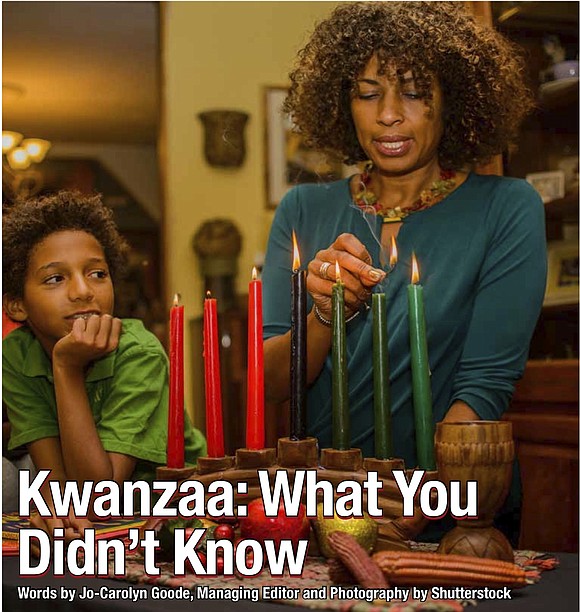Kwanzaa: What You Didn’t Know
Jo-Carolyn Goode | 12/27/2018, 7:44 p.m.
We have decked the halls, jingled the bells, and sung the carols but there is still more holiday celebration. After Christmas comes the season of Kwanzaa. Founded in 1966 by Maulana Karenga, Kwanzaa is a holiday based on African principles and is celebrated from December 26 to January 1. Most are familiar with the seven principles but may not be knowledgeable about other aspects of the holiday. Continue reading to find out what you don’t know about Kwanzaa.
Symbols of Kwanzaa
The seven principles of Kwanzaa are unity, self-determination, collective work and responsibility, cooperative economics, purpose, creativity, and faith. But did you know there are also seven symbols of Kwanzaa. The symbols are just as important as the principles as the symbols are the visual representations that help with the meaning of the holiday. The symbols are crops, placemats, ear of corn, candles, candle holders, communal cups and gifts.
The crops represent the first fruits of the harvest that feed the people. Kwanzaa is based on African harvest festivals. Kwanzaa is also Swahili for "matunda ya kwanza," which means "first fruits." A placemat is a next symbol, which represents the foundation of communities. It is believed that nothing can be built without a solid foundation. Ear of corn represents the foundation of the communities, the family, specifically the offspring of parents. During Kwanzaa one ear of corn is placed on the mat for every child in the family. The seven candles symbolize the seven principles of Kwanzaa. A black candle is for unity and is placed in the center of the Kinara. Three red candles are for self-determination, cooperative economics, and creativity and are placed to the left of the black candle. Three green candles representing collective work and responsibility, purpose, and faith are placed to the right of the black candle. According to officialkwanzaawebsite.org, the candles colors are black for the people, red for their struggle, and green for the future and hope that comes from their struggle. The candleholder or Kinara is a symbol to hold the seven candles. Some have said that the candleholder represents stalks of corn that branch off to form new stalks, like a family tree. Communal cups or unity cup is a symbol to honor those that came before, the ancestors. During Kwanzaa, family members drink from the cup saying "harambee" which means, "let's pull together." Lastly is the symbol of gifts. Unlike Christmas, gifts are not those purchase from stores but are handcrafted and from the heart. These gifts are the fruits of labor and are rewards for seeds sown by children.
Not an African holiday
A big myth about Kwanzaa is that it is an African holiday. In fact, Kwanzaa is a U.S. holiday based on African principles. Karenga founded Kwanzaa during a time when racial tension heightened in the U.S. after the riots in 1965 of the Watts neighborhood in Los Angles, CA. It was his hope to create black pride and stronger communities.
Now the holiday is widely celebrated and has grown in popularity outside the U.S. Black Caribbean are also known to celebrate the holiday. In addition, the holiday has become more mainstream with the U.S. Postal Service creating a Kwanzaa stamp in 1997.
Official greeting
Besides lighting candles and exchanging gifts, those who celebrate Kwanzaa are known to have their own greeting. It is not uncommon to hear the phrase Habari gani during the weeklong celebration. The phrase is Swahili for “What’s the news?” Upon hearing the question, the appropriate response is the principle of the day.
The Black Candle
Did you know there is a film depicting all you need to know about Kwanzaa called “The Black Candle?” Narrated by famed poet Maya Angelou, “The Black Candle” is the first full-length film about the growth of the holiday using the story of a black family as its backdrops. Also starring in this film directed by M.K. Asante Jr. are rapper Chuck D, Kwanzaa founder Maulana Karenga, former NFL star Jim Brown, Molefi Kete Asante, Lovensky Jean-Baptiste, Haki R. Madhubuti, Theodore Perkins, Dead Prez, and Synthia Saint James.








